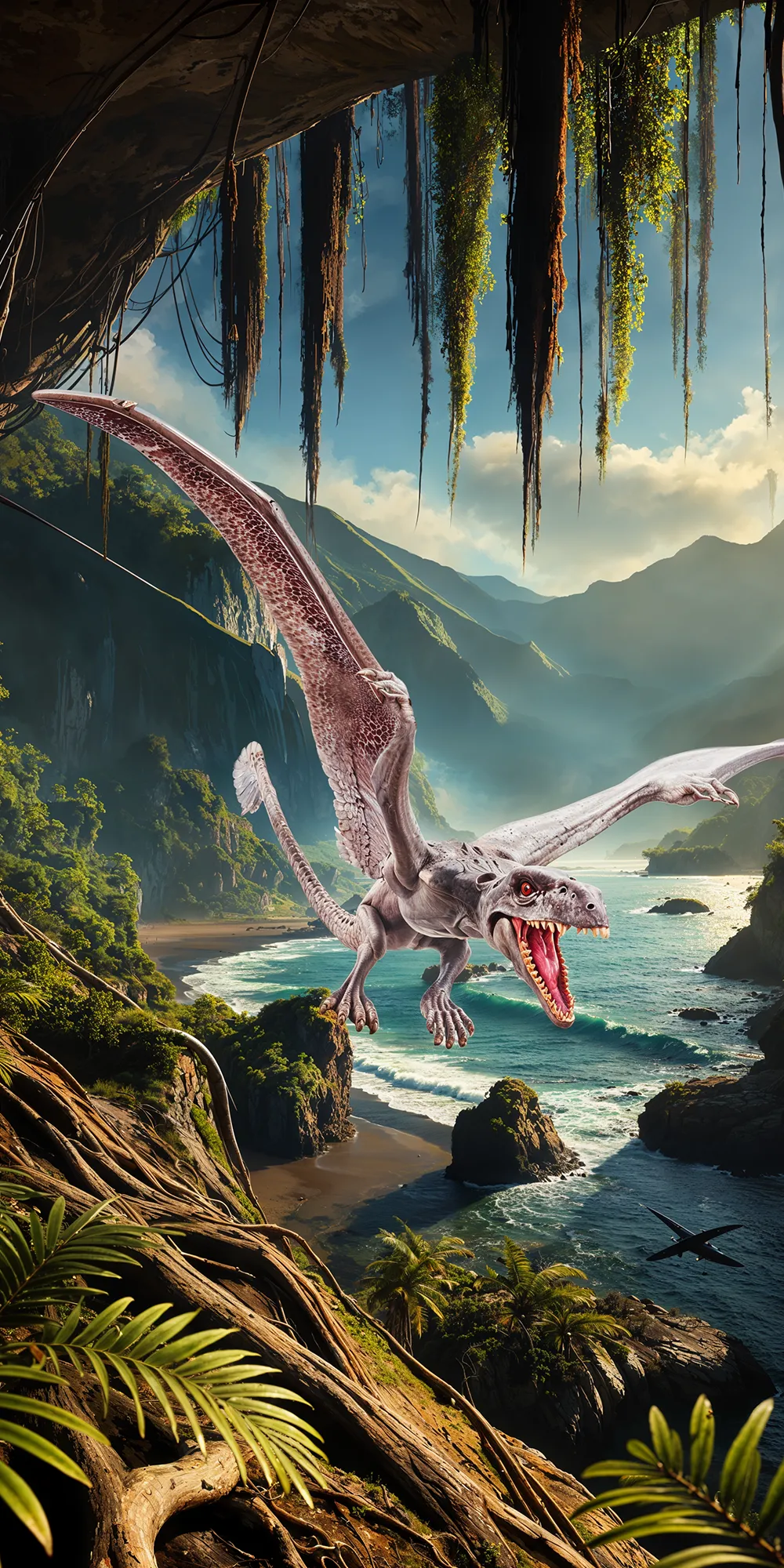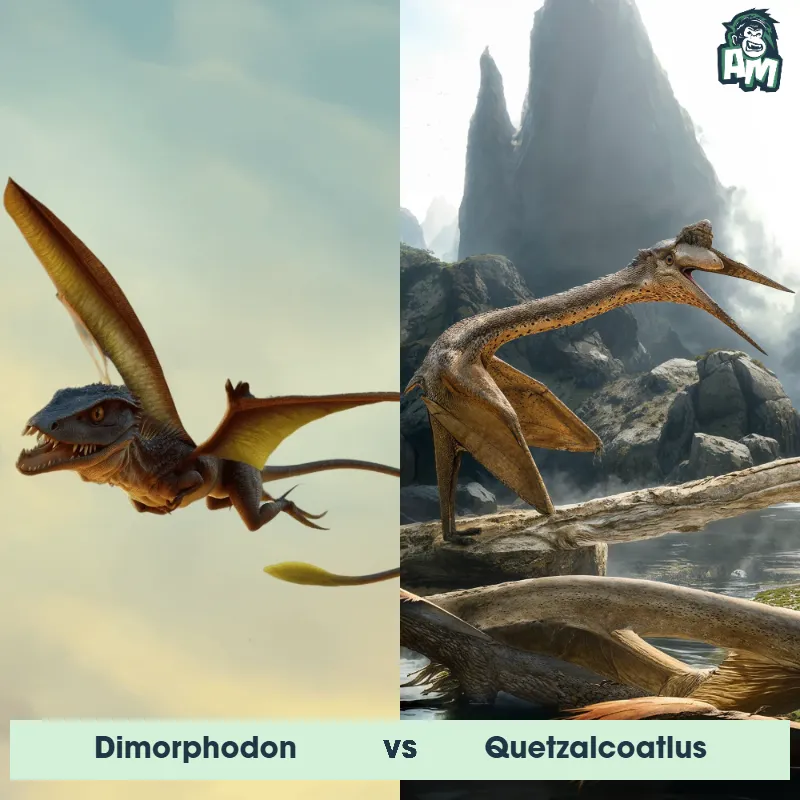The Dimorphodon
The Dimorphodon, also known as the "two-form tooth," is a genus of pterosaur that lived during the Early Jurassic period. It had a wingspan of about four feet and featured a unique skull with two different types of teeth. Its name comes from the fact that it had two distinct sets of teeth in its jaws, including long sharp teeth in front and shorter, flatter teeth towards the back for crushing prey. Dimorphodon is believed to have been a carnivorous flyer, hunting for small animals.

| Dimorphodon | |
|---|---|
| Size | Wingspan of about 4 feet (1.2 meters) |
| Weight | About 5 pounds (2.3 kilograms) |
| Speed | 20 mph (32 km/h) |
| Key Strength | Speed and agility |
| Biggest Weakness | Size and physical strength |
| Scientific Name | Dimorphodon |
| Family | Dimorphodontidae |
| Habitat | Coastal areas |
| Geography | Early Jurassic period |
| Diet | Fish, small animals, and tough prey |
| Lifespan | 12 years - 14 years |

The Dimorphodon
The Dimorphodon, also known as the "two-form tooth," is a genus of pterosaur that lived during the Early Jurassic period. It had a wingspan of about four feet and featured a unique skull with two different types of teeth. Its name comes from the fact that it had two distinct sets of teeth in its jaws, including long sharp teeth in front and shorter, flatter teeth towards the back for crushing prey. Dimorphodon is believed to have been a carnivorous flyer, hunting for small animals.
Fun Fact: Dimorphodon is one of the earliest known pterosaurs, with fossils dating back over 200 million years ago.
| Dimorphodon | |
|---|---|
| Size | Wingspan of about 4 feet (1.2 meters) |
| Weight | About 5 pounds (2.3 kilograms) |
| Speed | 20 mph (32 km/h) |
| Key Strength | Speed and agility |
| Biggest Weakness | Size and physical strength |
| Scientific Name | Dimorphodon |
| Family | Dimorphodontidae |
| Habitat | Coastal areas |
| Geography | Early Jurassic period |
| Diet | Fish, small animals, and tough prey |
| Lifespan | 12 years - 14 years |
Dimorphodon Matchups
We use AI to simulate matchups between the Dimorphodon and other animals. Our simulation considers size, strength, and natural predatory behaviors to determine the most likely outcome.

Can't find the Matchup you want?
Create Your Own MatchupDimorphodon: Diet, Predators, Aggression, and Defensive Behaviors
What did Dimorphodons eat?
Dimorphodons were carnivorous reptiles and primarily fed on fish, small mammals, insects, and other small animals. They used their sharp teeth and beak to catch and consume their prey.
Did Dimorphodons have any predators?
Dimorphodons were relatively small in size compared to other prehistoric creatures, making them vulnerable to larger predators. Some potential predators of Dimorphodons could have included larger flying reptiles, predatory dinosaurs, and even larger marine creatures if they ventured near bodies of water.
Were Dimorphodons aggressive?
Dimorphodons were not typically aggressive towards other creatures unless threatened or provoked. They were known to be territorial, especially during breeding seasons, but they would rather flee or avoid confrontations with larger predators.
Did Dimorphodons fight?
Dimorphodons may have engaged in physical disputes amongst themselves for territory or mating rights, often using their sharp beaks and claws to intimidate rivals. However, they were not known for engaging in prolonged or deadly fights like some other prehistoric creatures.
How did Dimorphodons defend themselves?
Dimorphodons had a few methods of defending themselves against predators or threats. They were agile flyers, capable of quickly escaping dangerous situations by taking to the air. Additionally, they could use their sharp beaks and claws to strike back if cornered, though their primary defense mechanism was to evade and avoid confrontation.
What was the biggest weakness of Dimorphodons in a fight?
The biggest weakness of Dimorphodons in a fight was their relatively small size and fragile build compared to larger predators. While they had sharp teeth and claws, they were not as powerful or well-equipped for combat as some other prehistoric creatures, making them vulnerable to being overpowered in direct confrontations.
Fun Fact: Unlike most pterosaurs, Dimorphodon had a shorter tail and only two elongated fingers to support its wings, making it a unique and interesting flying reptile.
Fun Fact: Scientists have speculated that Dimorphodon may have had a colorful crest on its head, adding to its unique appearance among other pterosaurs.











